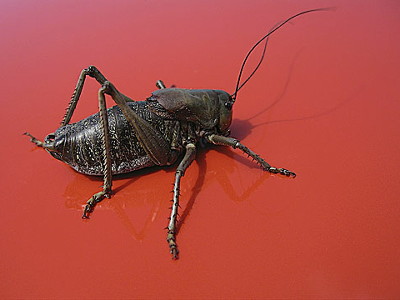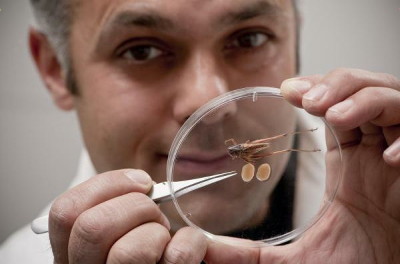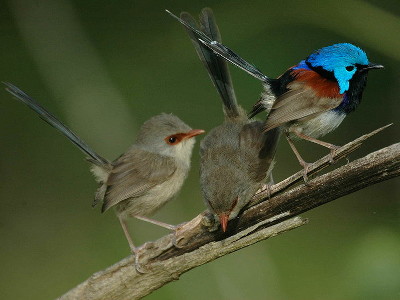14% of your weight, why did the testes of grasshoppers become the world's huge?

"Tuberous Bushcricket"GrasshopperofTestesIt accounts for 14% of the body weight, and in terms of the body weight ratio it is the size of the animal kingdomDerby UniversityWhenCambridge UniversityIt was clarified by the investigation of biologists.
It has also revealed a slight surprising truth that overcomes the common sense of biological sciences that it does not necessarily shoot a large amount of sperm from a huge testicle. So why did the grasshopper evolve to have such a huge testicle so much?
Details are as below.Bushcricket has the largest testicles relative to body mass of any animal
The grasshopper has a large testicular weight ratio among insects,DrosophilaA kindDrosophila bifurca(Longest in organisms on earthsperm, Which is 5.6 cm in one cell when stretching sperm wound in a coil shape) is 10.6% of the body weight, whereas the Tuberous Bushcricket (scientific name Platycleis affinis) species with a huge testicle among the grasslands It is said that the testes occupy 13.8% of the body weight.
Although it may be hard to imagine how big it is even if 14% of the body weight is called a testicle, human testicles are on averageVolume is 20 to 40 ml Weight is 10 to 15 gIt is said that even men with a relatively large testicle at a weight of 60 kg have only 1/4000 (0.025%) of their weight. For a 60 kg male to have a grasshopper-like testicle in the body weight ratio, it is necessary to grow the testicle to about 670 times to 1000 times the present time and to increase the weight by 10 kg just by the testis alone. Simply thinking that if the weight becomes 1000 times, the volume will become 1000 times, it seems that 20 liters to 40 liters of liquid will be hanging between the legs.
However, it seems that not all grasshoppers have such huge testicles so far. Dr. Karim Vahed of Derby University and colleagues collected 21 adults of the grasshopper living in various parts of Europe from the middle of August to the beginning of September and weighed the weight and the testicle weight with accuracy of 0.1 mg unit, Body weight ratio and reproductive behavior (one ejaculation amount andFemale YutakaTrends and so on). Thesis isBiology LettersIt is published in the magazine.
As a result, the testes weight in 21 grasshoppers was a minimum of 2.7 mg (Metrioptera roeseli) Up to 70.1 mg (Platycleis affinis), the ratio of testes to body weight was 1% (Gampsocleis glabra and Ephippiger ephippiger) to 13.8% (Platycleis affinis), and the body weight ratio of testes The point that it is big is that it is applicable to general theory in biology that "the testes are big because the females compete more intensely competing, but unexpectedly, sperm that is ejaculated at one time The amount does not correlate with the one - female multiple tendency, but in Platycleis affinis, which is the largest testis, it seems that the ejaculation amount of one time is less than the species with other smaller testes.
Dr. Karim Vahed holding a sample of Tuberous Bushcricket and its testicles. "I was amazed by a huge testicle that occupied most of the abdomen," he says.

In the animal kingdom, including fish and birds, insects and mammals, there is a tendency that the female testes become larger relative to the body as the females mate with many males during breeding season. This is because individuals capable of fertilizing females female by ejaculating large amounts of spermatozoa from large testes and female females with higher probability become advantageous when male competes fiercely, so that the whole species seems to have a trait that the testes are large It has been generally thought that it is because it has evolved into.
However, the result of this study that large testes male does not necessarily have a large amount of ejaculation necessarily overthrows it. About this, Dr. Vahed, in the case of the grasshopper, in a female multiple males such as Platycleis affinis that females with 23 male in the breeding season of females for 2 months, male also has opportunities to copulate with many females It is said that the evolutionary power that a chance to leave descendants becomes large in an individual who can copulate several females in keeping up keeping sperm of several times in a large testicle as it is said that it has worked.
Taking a policy that the female "mates with many males and obtains male genes resistant to reproductive competition", Male said, "Instead of surely fertilizing one female, mating with as many females as possible It seems to evolve in the direction that one who fertilizes some of them can efficiently leave offspring. "
Related Posts:







